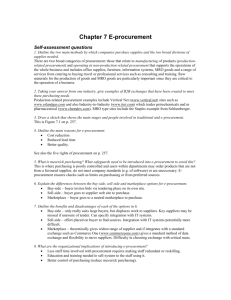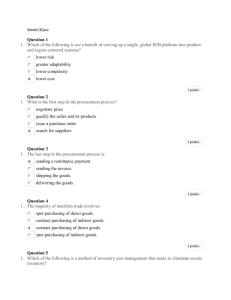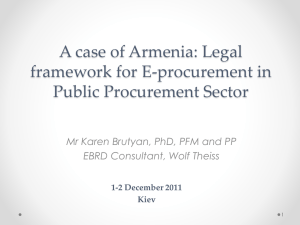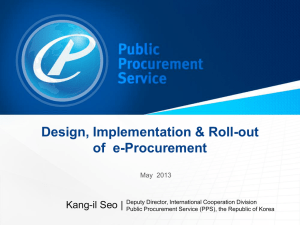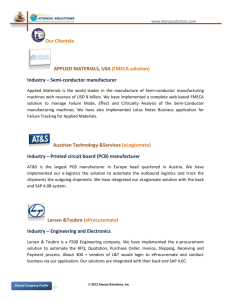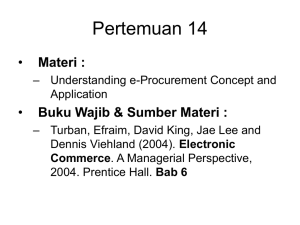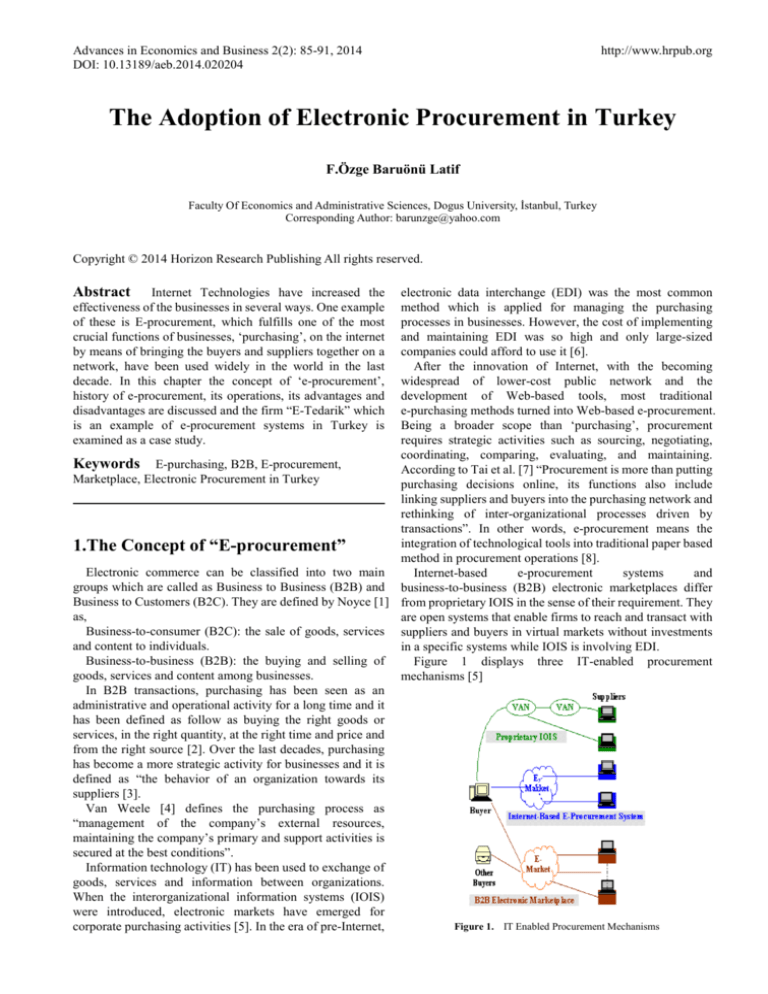
Advances in Economics and Business 2(2): 85-91, 2014
DOI: 10.13189/aeb.2014.020204
http://www.hrpub.org
The Adoption of Electronic Procurement in Turkey
F.Özge Baruönü Latif
Faculty Of Economics and Administrative Sciences, Dogus University, İstanbul, Turkey
Corresponding Author: barunzge@yahoo.com
Copyright © 2014 Horizon Research Publishing All rights reserved.
Abstract
Internet Technologies have increased the
effectiveness of the businesses in several ways. One example
of these is E-procurement, which fulfills one of the most
crucial functions of businesses, ‘purchasing’, on the internet
by means of bringing the buyers and suppliers together on a
network, have been used widely in the world in the last
decade. In this chapter the concept of ‘e-procurement’,
history of e-procurement, its operations, its advantages and
disadvantages are discussed and the firm “E-Tedarik” which
is an example of e-procurement systems in Turkey is
examined as a case study.
electronic data interchange (EDI) was the most common
method which is applied for managing the purchasing
processes in businesses. However, the cost of implementing
and maintaining EDI was so high and only large-sized
companies could afford to use it [6].
After the innovation of Internet, with the becoming
widespread of lower-cost public network and the
development of Web-based tools, most traditional
e-purchasing methods turned into Web-based e-procurement.
Being a broader scope than ‘purchasing’, procurement
requires strategic activities such as sourcing, negotiating,
coordinating, comparing, evaluating, and maintaining.
Keywords E-purchasing, B2B, E-procurement,
According to Tai et al. [7] “Procurement is more than putting
Marketplace, Electronic Procurement in Turkey
purchasing decisions online, its functions also include
linking suppliers and buyers into the purchasing network and
rethinking of inter-organizational processes driven by
transactions”. In other words, e-procurement means the
integration of technological tools into traditional paper based
1.The Concept of “E-procurement”
method in procurement operations [8].
Electronic commerce can be classified into two main
Internet-based
e-procurement
systems
and
groups which are called as Business to Business (B2B) and business-to-business (B2B) electronic marketplaces differ
Business to Customers (B2C). They are defined by Noyce [1] from proprietary IOIS in the sense of their requirement. They
as,
are open systems that enable firms to reach and transact with
Business-to-consumer (B2C): the sale of goods, services suppliers and buyers in virtual markets without investments
and content to individuals.
in a specific systems while IOIS is involving EDI.
Business-to-business (B2B): the buying and selling of
Figure 1 displays three IT-enabled procurement
goods, services and content among businesses.
mechanisms [5]
In B2B transactions, purchasing has been seen as an
administrative and operational activity for a long time and it
has been defined as follow as buying the right goods or
services, in the right quantity, at the right time and price and
from the right source [2]. Over the last decades, purchasing
has become a more strategic activity for businesses and it is
defined as “the behavior of an organization towards its
suppliers [3].
Van Weele [4] defines the purchasing process as
“management of the company’s external resources,
maintaining the company’s primary and support activities is
secured at the best conditions”.
Information technology (IT) has been used to exchange of
goods, services and information between organizations.
When the interorganizational information systems (IOIS)
were introduced, electronic markets have emerged for
Figure 1. IT Enabled Procurement Mechanisms
corporate purchasing activities [5]. In the era of pre-Internet,
86
The Adoption of Electronic Procurement in Turkey
Internet-based e-procurement systems as digital
intermediaries generate virtual marketplaces where the firms
transact with each other after they register. The marketplace
creates value by bringing buyers and sellers together directly.
On the other hand, B2B electronic markets provide open
transaction networks where a large number of potential
buyers and sellers are able to participate without the
restrictions of time and space. In a B2B electronic market
place suppliers are able to see the proposals of the other
parties to the buyers as well. Both for buyers and sellers, it
creates more purchasing alternatives, more benefits and
more time efficiency [5].
2. The Evolution of “E-procurement”
In 2000’s, B2B e-commerce had a meaning much more
than online auctions and digital catalogs [9]. The evolution
of e-procurement sites has been so swiftly, but there have
been some mile stones. Firstly, giant corporations such as
General Electric and Wal-Mart created buying and selling
centers in the Internet which are used to decrease costs and
speed supply procurement. After that, the third-party
exchanges emerged. They brought together many buyers and
sellers in a virtual market. Finally, major players of some
vertical industries, such as GM, Ford, and Daimler Chrysler
have joined in e-procurement system [9, 10].
In time, the emergence of web-based e-procurement has
transformed into the purchasing process from an operational
into a strategic activity [11, 12, 7].
E-procurement is used both by private and public sector
companies today. For the implementation of e-procurement
in the public sector, some extra factors should be taken into
consideration like financial risk, risks of building the portal,
and legislative issues [13, 14]. Besides, the diffusion of
e-procurement at the public organizations has been slow and
incremental because they are used to be the late adopters of
new technologies generally [15, 16]. Considering both
private and public sectors, The Center for Advanced
Procurement Studies reported in 2004, on average, 17
percent of all purchases are made through e-procurement and
three percent through e-auctions. Companies that adopt
e-sourcing tools report that they gain 50 % efficiency [17,
18].
3. The Structure of E-procurement
Procurement usually consists of two types of purchases.
They are direct and indirect purchases. Direct purchases
include all items needed to produce finished goods such as
raw materials, components, assemblies etc. Indirect
purchases involve items which firms need for their daily
operations and daily business activities. It requires a wide
variety of items (office and industrial supplies, office
equipments and travel and entertainment etc.) from several
industries and they are highly decentralized [12]. They are
bought in small quantities and less frequently in case of need.
Unlikely indirect purchases, direct purchases are made in
certain amounts and in a regular basis, so it requires
developing long term and trust-based relationship with the
suppliers.
E-procurement systems usually consist of two parts. First
one takes part on the top of the company’s intranet behind its
firewall and the staff is able to search and order for desired
supplies. After they have been approved, the purchase orders
are sent out to the third parties. This is where the second part
of the e-procurement system takes part. At the electronic
marketplace, these orders are transformed into various
formats and so they can be received and processed by
different suppliers [5].
There are three essential market functions: matching
demand and supply, enable transactions and providing
institutional configuration [19]. According to Bailey and
Bakos [20], B2B e-markets are digital intermediaries which
collect the product information and prices and provide
industry-specific expertise . To bring together buyers and
sellers electronic markets [5];
Collect supplier catalogs so that buyers can browse
and search for products.
Provide dynamic pricing and negotiating
mechanisms such as exchanges and auctions.
Support the users for logistics and financial payment.
One type of classifications of e-procurement sites
emphasizes the technical side of their operation. For example,
Deloitte Consulting identifies three types of B2B services
based on the content and features they offer [9, 21];
Online catalogs
Online auctions
Online exchanges
A general classification of web-based procurement system
has identified under 5 headings as shown in the Figure 2.
Each model creates value for the buyer and seller in unique
ways and organizations can use one of them or more than one
models according to their organizational needs [22, 23,24].
(a) Buy-side Procurement System
(b) Sell-side Procurement System
Advances in Economics and Business 2(2): 85-91, 2014
(c) Private Marketplace
(d) Industry B2B Exchange
(e) Industry B2B Exchange
Figure 2. Web-based procurement model [12,25 ]
Buy-side procurement system: This form of procurement
system is developed and implemented by large buyer
organization to purchase from selected suppliers. The entire
system, covering product development, transactions and
procurement management is web-enabled and integrated.
This creates a virtually integrated IOS between the buyer and
the seller, like the EDI system, but with greater scope and
capabilities. The advantages of this system are transaction
efficiency, ease of use and process control [12]
Sell-side procurement system: In this model, sellers create
their own web site which allows many buyers to browse and
purchase their products online, with real time. The sellers
use an open web site on the Internet to promote their
products. The obvious advantage for sellers is that they can
create their own catalogs. But it has some difficulties for
buyers because they still have to locate the supplier’s web
site, log on, enter orders manually through the catalog etc.
With a company with hundreds of suppliers, it means visiting
hundreds of web sites routinely [25].
Private marketplace (Private B2B E- market): This
independent portal enables multiple buyers and sellers to
meet electronically and transact all types of business through
a single site. The site allows any member to log on and
transact business for a subscription fee, a transaction charge
or a percentage of exchange fees. The advantage of private
electronic markets is on reducing the procurement price of
the items. Private e-markets also reduce search costs for
87
locating sellers and serve as exchange mechanisms for
proprietary knowledge of the enterprise [25].
Vertical E-Markets (Industry B2B exchange): Vertical
market trading communities focus on one particular
industry-steel, electricity, chemicals etc. According to
Subramaniam and Shaw [12], “The emphasis of
industry-wide exchanges is to increase transparency of the
process and force competition among suppliers, which
results in lower prices for buyers”. This model also reduces
the search costs for both buyers and sellers. In high-tech
manufacturing, 12 industry leaders, including HP, Compaq,
NEC, Samsung and others, have joined together to form an
electronic commerce community that will focus on the
high-tech components , and will offer open sourcing,
auctions, supply planning and logistics support [25].
Horizontal E-Markets: Horizontal trading communities
focus on broad categories including goods-office supplies,
furniture, travel services- that are common to large numbers
of cross-industry organizations. W.W Grainger is an
example of this community. Their Exchange,
OrderZone.com includes online ordering and invoicing and
provides customer with a single point of contact for access to
a wide variety of indirect products [25].
Auctions: Auctions provide an online, real-time exchange
for commodities in a particular vertical or horizontal industry
with logging on and making some type of low-price offer
against a request. The advantages of auctions are saving
times speed and reducing costs [25].
Each form of B2B procurement system has some pros and
cons. It is clear that organizations, buyers or sellers, have to
choose one of them or more than one to gain competitive
advantage and create economic benefits toward their needs.
There are some factors effecting on the adoption of
e-procurement in organizations. They are identified as;
Perceived barriers: The potential barriers of adopting
e-procurement are several. Some of them are
absence of the technological infrastructure needed to
support business operations, information [26]
perceived uncertainty regarding resource availability
and perceived difficulty of integrating new systems
[12] , the lack of integration of firms’ IT systems
[27] , lack of top management support) security, and
privacy of Exchange [28].
Perceived drivers: The potential barriers of adopting
e-procurement are saving cost and time, reducing
maverick buying [29] trying new suppliers easily,
finding more suppliers [30].
Firm size: Large firms are more likely to adopt
e-procurement than smaller firms due to their
information processing capacity, bargaining power,
and financial power [31]
Complexity of buying situation: As the buying
situation shift from straight rebuy to new task, the
purchasing task becomes more complex. Buyers
need more information from their suppliers to design
the new task buy [32].
88
The Adoption of Electronic Procurement in Turkey
4. Advantages and Disadvantages of
E-procurement
The advantages of E-procurement sites which are
examined in both several theoretical and empiric studies are
quoted as:
To cut costs of purchased goods and services
including the cost of goods and services purchased,
ordering, searching , communication, coordination
and holding costs [33,34].
Low barriers for market entrance [35]
Price transparency [9]
Increased search capabilities, faster processing,
real-time and rich-media information support [34]
To avoid from “maverick buying” [9]
Better balance of power between sellers and buyers
[35]
One-stop buying,
Comparison shopping for thousands of suppliers and
select the best in real time [5]
Do not need to make a commitment to a specific
procurement IS infrastructure [5].
Furthermore, some researches belonging to Aberdeen
Group, Cisco, Microsoft and Deloitte Consultant support
these results. According to the study of Aberdeen Group [18]
the ordering cost savings in manufacturing associated with
e-procurement vary between 2% and 39% of the costs of
goods and services purchased [9]. Cisco reports that
e-procurement has reduced their costs from $25 to $130, and
Microsoft, from $5 to $60 per order [9, 37].
A study, driven in U.S. by Deloitte Consulting [42] in the
fall of 1999, has reported that companies with revenues
greater than $1 billion revealed the following results [9].
The firms that use e-procurement solutions, 85%
said they were highly satisfied with the resulting
benefits.
More than 90% of firms have incorporated
e-procurement into their business plans, and
one-third of them have started implementing an
initial solution.
Most of the firms’ top e-business objectives are
related to procurement and the supply chain.
However, there are some difficulties of using
e-procurement, which are listed below [38, 35]
A gap between the expectations of the two sides of
the transaction.
Need more than one marketplace
High training costs derived from switching to
e-procurement
The high risk of compromising sensitive data
Low human contact
Another factor limiting usage of e-procurement system is
poor willingness of the suppliers to participate [39, 40].
Buyer firms which face this adversity either have to give up
or delay to use e-procurement systems or change their
suppliers.
5. The Case of “E-tedarik”
E-tedarik Bilişim Teknolojileri Ltd. Şti. (e-tedarik) was
established in Turkey in 2008 as a first corporate
e-procurment hub. While leading the process of procurement
of major companies, e-tedarik continues to grow fast and
robust steps in domestic and international markets by now.
“e-tedarik” has taken place in the industry as a new system
that meet the critical needs of customers with extensive
reporting and auditing facilities. This new e-procurement
system can be used immediately with only internet access,
without requiring any software or hardware investment. By
taking control of purchasing costs, by high savings in
procurement, by improving of procurement processes and
with important features like detailed reporting,
e-procurement is serving Türkiye’s leading institutions and
organizations and continues to create high customer
satisfaction. Independent from sector, size, purchasing
volume, geographical position and technological
infrastructures of a company, Electronic Procurement
(e-tedarik) management system supports to the customers for
developing their conventional procurement process. By
using the e-tedarik system customers can increase the
productivty in their procurement process, control over
demands, save the operational cost and have more
transparency in purchasing.
The e-procurement system of “e-tedarik” is consists of
three basic modules. They are; e-catalogue, e-purchasing and
e-auction modules. With these three modules customers can
supply their direct and indirect requirements. Especially, for
mid-sized or large companies, e-tedarik management system
supplies more systematic, more secure and reliable, more
controllable and less costly way for their indirect purchases
via outsourcing, instead of having burden some of the
in-house operations and being open to risk and uncontrolled
for the goods and services which includes scattered, various
and less valued items [43]. In short, these modules are
explained below:
e-catalogue is a "simple-to-use" and very effective
way to collect the requests from several departments
which are located in geografically different areas. By
using e-catalogue, the customers can control and
consolidate all the internal requests easily just from
very beginning of purchasing activity.
e-purchasing modul enables to create the orders in
standart templates and collect the requests from
suppliers easily. This templates facilitates placing the
bids more rapidly and accurately. Via e-purchasing
modul the collected requests are evaluated and
re-requested if it is necessary. After the evaluation,
the process ends with direct purchase or it is direced
to the e-auction modul.
e-auctions, generally mean "electronic reverse
auctions" refers to auctions which are conducted
using internet-based software . It ensures
transparency and equality of opportunity to all
participants. For the supplier, electronic auctions
Advances in Economics and Business 2(2): 85-91, 2014
offer the benefit of allowing bidders to participate
simultaneously, remotely and anonymously [43].
Their major users on the buyer side include, Migros (a big
retailer in Turkey), Coca Cola, Dogus Group ( one of the top
holdings including VW Group in Turkey, NTV Media,
Garanti Bank) , Eczacıbaşı (one of the top holdings in
pharmacy sector) , Demirdokum (a leading heating brand in
Turkey), and Electro world (an electronic retailer). On the
supplier side there are thousands of firms of different sizes
and from a wide range variety industries and average number
of pending bids is 182 [44].
The rapid increase in both the number of suppliers and
buyers and the number of transactions and total turnover
between the years 2008-2012 is shown in the Figure 3 and 4
respectively.
Figure 3. Number of Buyers between 2008-2012 [43]
Figure 4. Growth of e-tedarik [43]
It is clear that “e-tedarik” has facilitated the buyer firms
purchasing processes and has increased their purchasing
effectiveness. Some leading Turkish companies’ experience
with “e-tedarik” is summarized below.
Migros has begun using the e-procurement system in 2009,
and realized the purchase about 100 Million USD per year
through this system. Only through e-auction module savings
is around 25%. Around 400 e-auctions are performed per
year on the “e-tedarik” system [43].
Coca-Cola has begun to use the e-procurement system by
the end of 2009 and has reached a very high savings in a very
short time by using the e-auction module of the system.
Besides the benefits of e-auction, with the use of e-catalogue
and e-purchasing it provides considerable time and cost
savings in procurement process [43].
Demir Döküm, performs a large percentage of the
purchase through the e- procurement system. The
Procurement officials of Demir Döküm reported that the
89
underlying reason of their preference to use “e-tedarik” is its
transparency of the procurement policies, shortened the
acquisition times [43]
Electro World is also using “e-tedarik” procurement
system effectively to purchase with higher amounts in its
construction, electrical and mechanical infrastructure
operations [43].
The most frequently cited benefit of the system is reported by
the buyers as below:
Price savings of around 25% per unit.
Time savings
In shortening the time and effort which might
otherwise be involved in prolonged rounds of
post-tender negotiation
In facilitating the re-use of auction formats
The ability to open up procurement to a wider
market.
The transparency of the process to all participants
and an audit trail of activity.
Besides, the benefits of the system for the vendors are listed
as below;
Cutting the advertising expenses,
Gaining brand awareness
Creating new market opportunities
On the other hand, there may be certain reasons which
keep the firms away using electronic procurement systems.
General Manager of E-Tedarik.Co was interviewed about
them and according to him most of the reasons are
psychological reasons and derived from lack of information.
Most common concerns about e-procurement are listed
below:
E-procurement may slow the firm’s operation
because of the system’s procedures and data
entering.
E-procurement may not be used in emergency/urgent
cases.
Fear of the unknown technology
Concerns about supplier’s reluctance to use this
system
Organizational concerns (Procurement staff’s
opposition for perceived loss of power additional
accountability comes with the new system)
However, he added that, after the initial concerns, once
companies start using system, these concerns fizzle out.
Indeed, he claims when one of their client transferred to
another firm, he wanted to carry the system to his new
company as well.
Another drawback of the current system is that it doesn’t
include a payment system for connection with accounting
and inventory systems. Yet the firm is claiming that it is
working on a payment module on the system, so they will
able to serve all functions of buying with one integrated
e-procurement site.
In summary, buyer firms using “e-tedarik” as a main part
of their procurement system report that, they complete their
transactions more easily and rapidly than before.
Intermediary systems also provide more reliable and safer
90
The Adoption of Electronic Procurement in Turkey
business climate for both buyer and seller parties. Although
e-tedarik and other similar intermediary systems are
considerably new in Turkey, because of their virtues,
probably they will become more widespread and their usage
will increase.
January 2001, Maui, HI.,2000
[6]
J. Gebauer, P. Buxman. Assessing The Value of
Interorganizational
Systems
to
Support
Business
Transactions. International Journal of Electronic Commerce,
4 (4), 61-82, 2000
[7]
Y Tai., C. Ho, W. H Wu. The Performance Impact of
Implementing
Web-based
e-Procurement
Systems
International Journal of Production Research Vol. 48, No. 18,
15 September 5397–5414,2010
[8]
H. Min & W.P. Galle . E-purchasing: Profiles of Adopters and
Nonadopters. Industrial Marketing Management 32 (3)
227-233,2003
[9]
E.A. Ageshin. E-Procurement At Work : A Case Study.
Production and Inventory Management Journal -First Quarter.
48-53, 2001
6. Conclusion
As a result of the developments in Internet Technologies,
electronic markets have emerged. Today these electronic
markets are used in a variety of industries, including
automotive, food and beverage, chemicals, automotive and
so on. As an integrated purchasing system, e-procurement
helps companies to source input products and services at the
lowest cost, while ensuring that those inputs meet technical
and other specifications.
This new way of doing business brings both opportunities
and difficulties. The most prominent advantages are
reducing the searching, communication, coordination,
ordering and holding costs and enhancing search capabilities,
accelerating the process with real-time information support.
On the other hand high training costs of switching to
e-procurement and lessened human interaction are keeping
the firms away.
The framework that we presented in this chapter serves a
theoretical background about the e-procurement systems and
its usage in practice. “e-tedarik” is the pioneer of this new
e-business model in Turkey and its story and its implications
are quite new for the Turkish market. We think that this
business model could be an example for the other
entrepreneurships and the facilities served by the firm will be
incentive for the procurement professionals. However,
procurement professionals have to analyze carefully the
advantages of the system for their business and determine
what form of e-procurement is best to use in each phase of
the purchasing process.
REFERENCES
[1]
D. Noyce.e B2B: Analysis of Business to Business
E-Commerce and How Research Can Adapt to Meet Future
Challenges, International Journal of Market Research, 44(1),
71–95, 2002
[2]
S. Heinritz, P. Farrwell , C. Smith, Purchasing: principles and
applications. Prentice Hall, Englewoods Cliffs 1986
[3]
L.E Gadde, H. Hakkansson. Professional Purchasing.
Routledge, London, 1993
[4]
A.J. Van Weele. Purchasing and Supply Chain Management:
Analysis, Planning and Practice, Cengage (5th ed.), London,
2010
[5]
Q Dai, R.J. Kaufmann . Business Models For Internet-based
E-Procurement Systems and B2B Electronic Markets. 34th
Hawaii International Conference on Systems Science,
[10] D Ong. Putting B2B Hype in Perspective. Business Times
(Singapore), 2000
[11] K. A. Saeed, M.K. Malhortra, V. Grover Examining The
Impact of Interorganizational Systems on Process Efficiency
and Sourcing Leverage in Buyer–supplier Dyads. Decision
Sciences, 36 (3), 365-396, 2005
[12] C. Subramaniam, M. Shaw. A Study of Value and Impact of
B2B E-commerce: The Case of Web-based Procurement.
International Journal of Electronic Commerce, 6 (4),
19-40.,2002
[13] Henriksen H. Z & Mahnke V. E Procurement Adoption in the
Danish Public Sector, Scandinavian Journal of Information
Systems,, 17(2),85–106, 2005
[14] Oliveira, L. M. S. &Amorim, P. P. Public E-Procurement.
International Financial Law Review, (20:3), 43-47,2001
[15] M. J. Moon (2005). E-procurement management in state
governments: Diffusion of e-procurement practices and its
determinants. Journal of Public Procurement 5 (1),. 54–72,
2005
[16] S. MacManus, Understanding the Incremental Nature of
E-Procurement Implementation at the State and Local Levels.
Journal of Public Procurement, 2 (1),5-28, 2002
[17] S.L Kulp, T. Randall, G Brandyberry G., K. Potts . Using
Organizational Control Mechanisms To Enhance
Procurement Efficiency: How Glaxosmithkline Improved
The Effectiveness Of E-Procurement,Interfaces Vol. 36, No.
3, May–June 2006,. 209–219, 2006
[18] Aberdeen Group. Optimizing and sustaining supply savings:
Best practices and e-sourcing. (September). Research Report,
Aberdeen Group, Boston, MA., 2004
[19] J.Y Bakos, The Emerging Role of Electronic Marketplaces on
the Internet. Communications of the ACM, Vol. 41 (8), pp.
35-42, 1998
[20] J.P Bailey, J.Y. Bakos .An Explatory Study Of The Emerging
Role of Electronic Intermediaries. International Journal of
Electronic Commerce, 1, 7-20, 1993
[21] H. Solomon. The Year of the B2B Boom. Computing Canada
26, No. 2 : 24, 2000
[22] S. Kaplan, M. Sawhney . E-Hubs: The New B2B
Marketplaces. Harvard Business Review, May-June, pp.
Advances in Economics and Business 2(2): 85-91, 2014
97-103, 2000
[23] B. Mahadevan. Business Models for Internet-Based
E-Commerce: An Anatomy. California Management Review,
Vol. 42 (4), Summer, pp. 55-69, 2000
[24] C. Phillips, & M Meeker. The B2B Internet Report:
Collaborative Commerce. Morgan Stanley Dean Witter
Report, April, Stanley Dean Witter & Co, 2000
[25] D. Neef E-procurement From Strategy to Implementation.
Prentice Hall, NJ, USA, 2001
[26] P. Bingi, A. Mir, J. Khamalah. The challenges facing global
e-commerce. Information System Management 17 (4), 72–83,
2000
[27] P. Hawking,., A. Stein, D. C. Wyld, S. Foster. E-Procurement:
Is the ugly ducking actually a swan down under? Asian
Pacific Journal of Marketing and Logistics 16 (1),3–26, 2004
[28] C. B Kheng, S. Al Hawamdeh. The adoption of electronic
procurement in Singapore. Electronic Commerce Research 2
(1–2), 61–73, 2002
[29] A. Davila, M. Gupta, R. Palmer. Moving procurement
systems to the Internet: Adoption and use of e-procurement
technology. European Management Journal 21 (1),.11–23,
2003
[30] E. Bartizzaghi, S. Ronchi. Internet supporting the
procurement process: Lesson from four cases studies.
Integrated Manufacturing System 14 (8), 632–641, 2003
[31] M Sigala. e-Procurement diffusion in the supply chain of food
service operators: An exploratory study in Greece.
Information Technology and Tourism 8 (2), 79–90, 2006
[32] B., J. Sain, D. Owens, J. D. Hill. Advances in e-procurement:
A focus on the product buying situation. Journal of
Management Services 48 (6), 10–14,2004
[33] C. Nowikow. Revolution, or
Management 4,No. 19:26–32,1999
E-volution?
Supply
91
[34] P. Buxmann, J. Gebauer. “Evaluating the Use of Information
Technology
in
Inter-Organizational
Relationships,”
Proceedings of the Hawaii International Conference on
System Sciences, January 5-8, Maui, Hawaii, 1999
[35] P. Marks. E-procurement in Perspective. Computer-Aided
Engineering (50) 19, No. 2, 2000
[36] S .V. Brull. Such Busy Bees in B2B. Business Week. (2000
March 27).
[37] N. Tait . Full Speed Ahead in New Economy: Electronic
Purchasing Survey. Financial Times, February 29: 2, 2000
[38] W.C. Copacino. E-Procurement: Beyond Tickets and
Turkeys.”Logistics Management & Distribution Report 38,
No. 7 (42), 1999
[39] K. Dooley,S. Purchase Factors Influencing E-Procurement
Usage. Journal of Public Procurement Volume 6 Issues 1&3,
28-45, 2006
[40] A. Bartels, R. Hudson, T. Pohlmann,. “ISM/Forrester Report
on Technology in Supply Management.” TechStrategy:, 1-9.
2003, October 27
[41] Pricewaterhouse Coopers Selected by General Motors as
Lead E-Business Integrator for B2B E-Commerce Initiatives.
Business Wire. Retrieved from www.businesswire.com,
February 24, 2000
[42] Deloitte. Study Shows Big Early Returns From
E-procurement Investments. Industrial Distribution 89, No.
2:40,2000
[43] e-procurement, retrieved from www.etedarik.com August 20,
2012.
[44] e-tedarik
Our
Customers,
retrieved
www.etedarikmerkezi.com August 21, 2012
from

